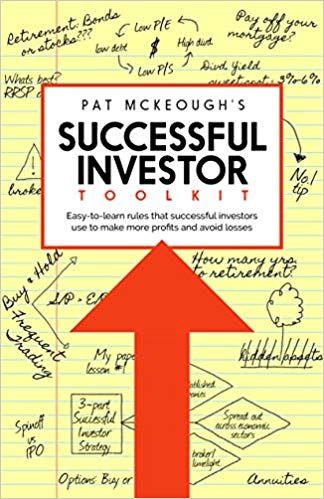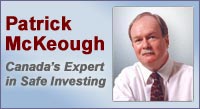 My latest MoneySense Retired Money column looks at how near-retirees can avoid what author Patrick McKeough calls “pre-retirement financial stress syndrome.”
My latest MoneySense Retired Money column looks at how near-retirees can avoid what author Patrick McKeough calls “pre-retirement financial stress syndrome.”
That’s a syndrome he identifies in his new book, Pat McKeough’s Successful Investor Toolkit. McKeough is a regular contributor here at the Hub and you can find the full MoneySense review of his book by clicking on the highlighted text: Investing tips for retired Canadians.
The book is a distillation of McKeough’s long investment career, honed first at The Investment Reporter, and in recent years his own firm, The Successful Investor, and its stable of newsletters. As a member of his Inner Circle and TSI Network, I have long been a proponent of his common-sense approach to investing. He is remarkably consistent in his insistence that investors of any age rely mostly on a conservative portfolio of quality dividend-paying stocks spread among the five major economic sectors (Manufacturing & Industry, Resources, Finance, Utilities and Consumer). And, he never fails to remind you, steer clear of stocks in the crosshairs of what he calls the “broker/media limelight.”
His newsletters are focused variously on Canadian stocks and U.S. and international stocks, and in recent years he has increased his coverage of ETFs.
A cure for PRFSS: Work longer or refine your spending
So what is“pre-retirement financial stress syndrome,” or PRFSS? PRFSS strikes when mature investors realize they may not have enough savings to generate the stream of retirement income they’d been counting on. While some investors are searching for one last desperate “hail Mary” gamble, McKeough advises the opposite: aiming for safer investments.
And while it may not be what some may want to hear, he suggests those suffering from PRFSS adopt one or both of these two solutions: work longer and/or refine your spending. He challenges them to “turn frugality into a game.”
With his focus on stocks, it’s no surprise that McKeough is not keen on bonds, even for retirees and those on the cusp of it. That said, he cautions against taking too much stock risk in RRSPs or TFSAs. He reminds retirees that the decumulation phase of investing is the reverse of the Wealth accumulation days when investors accumulated stocks by dollar-cost averaging into both good and bad markets. In retirement, “you reverse the process. You live off your dividends and sell stocks mainly when you need more money.” It’s natural to sell one’s lower-quality holdings first, which means you are steadily upgrading the quality of your investment portfolio. He advises against attempting to time the market and urges investors to “get used to uncertainty.” Investors think about the possibility of short-term declines too much: “Far better to focus on investment quality, along with portfolio balance and diversification.”
North American focus but foreign stocks have a place
 McKeough’s advice for his predominantly Canadian audience tends to be to focus on North America, especially US stocks that are not abundant in the Canadian marketplace (that is, outside financials, energy and materials). He notes that foreign stocks go “in and out of fashion with North American investors” and — note well — “Investors tend to over-rate the profit potential of foreign stocks, and underestimate their risk.”
McKeough’s advice for his predominantly Canadian audience tends to be to focus on North America, especially US stocks that are not abundant in the Canadian marketplace (that is, outside financials, energy and materials). He notes that foreign stocks go “in and out of fashion with North American investors” and — note well — “Investors tend to over-rate the profit potential of foreign stocks, and underestimate their risk.”
Canadian investors can lower this risk investing in three ways: buying high-quality U.S. and Canadian multinationals that have international operations; using American Depositary Receipts (ADRs) that let you buy foreign shares for US dollars on U.S. stock exchanges; and third, use international ETFs. But again, McKeough cautions that investors — especially those near or in retirement — should “limit these holdings to a small part of your portfolio.” The core should be here in North America.

